
Earlier this month the United States released the remaining members of the Cuban Five — Gerardo Hernández, Antonio Guerrero and Ramón Labañino — as part of a deal to restore diplomatic ties with Cuba. We rebroadcast a 2013 interview with the first freed member of the Cuban Five, René González. The five Cuban intelligence agents were arrested in the United States in 1998 and convicted of conspiracy to commit espionage. They say they were not spying on the United States, but rather trying to monitor violent right-wing Cuban exile groups responsible for attacks inside Cuba.
Transcript
AMY GOODMAN: This is Democracy Now!, democracynow.org, The War and Peace Report. I’m Amy Goodman, as we turn now to René González, the first freed member of the Cuban Five. The last three were released earlier this month as part of a deal with the United States and Cuba in beginning normalizing relations. René González was released in October 2011 after being jailed in the United States for 13 years. In October of 2013, just over a year ago, I spoke to René González in Havana via Democracy Now! video stream. I began by asking him why he came to the United States to investigate militant Cuban exile groups.
RENÉ GONZÁLEZ: Well, for my generation Cubans, it was part of our development or common experience to have seen people coming from Miami raiding our shores, shooting at hotels, killing people here in Cuba, blowing up airplanes. So, we were really familiar with the terrorist activities that the Cuban people had been suffering for almost four years back then. So it wasn’t hard for me to accept the mission of going there and monitor the activities of some of those people, who had been trained by the CIA in the '60s. Some of them had participated in Bay of Pigs. Some of them had gone then—after that, had gone to South America as part of the Operation Condor. And if you look at the history of those people, you can see their link to the worst actions of the U.S. government, be they Iran-Contras—even the Kennedy assassination plot was linked to them. So, it wasn't hard for me to accept the mission and to go there to protect the Cuban people’s lives, and that’s what I did.
AMY GOODMAN: What were some of the groups that you and your colleagues came to infiltrate? What were their names, and what specifically did you know they were doing in Miami?
RENÉ GONZÁLEZ: Well, if we are talking about that, we should start by Luis Posada Carriles, who’s still in Miami. He’s living there under the protection of the U.S. government. Posada Carriles has a long story of terrorism against not only Cuba, but also even in the United States. He was responsible for the blowing up of the Cubana airliner in 1976 in Venezuela. And later on, when we were in Miami, he was also organizing the bombs which were placed on the hotels in Havana. But it’s not only him. I mean, he doesn’t work alone. The sad part is that he was being paid for by the Cuban American National Foundation, which is a legal organization linked to the Washington establishment, an organization which has a lobby in Washington, which has paid for the election campaigns of guys like Ileana Ros or Lincoln Diaz-Balart. And those people were paying these terrorists—that terrorist to put bombs in Havana in 1997. So that’s an example of the whole scheme that we were facing there.
And, of course, there were some other people, like José Basulto, who founded Brothers to the Rescue, but before that he had a long history of terrorism against Cuba. We had Orlando Bosch, who together with Luis Posada Carriles, was involved in the plot in Venezuela to blow up the Cubana airliner. And we have, for example, the Novo Sampoll brothers, who were linked to the assassination of Orlando Letelier in Washington with a car bomb. So the list is long, but those are the—those were the people we were watching on, and that was our mission there.
AMY GOODMAN: How did you make it from Cuba to Miami? Explain how you came up.
RENÉ GONZÁLEZ: Well, I was a pilot here in Cuba. So I was flying with the skydiving operations here for sports operations. And, well, I took a chance and stole a plane, and I landed in Key West. Of course, I had been born in the United States, so when I landed there, I showed my birth certificate, and then they allowed me to go back to my family’s house. And then I ended up with Brothers to the Rescue, which was the first organization that I infiltrated there. And the rest was just linking up with all those people and, you know, going from one group to another to find out their plots against the country.
AMY GOODMAN: And what most surprised you about what you found in the linkages of these groups, from Brothers to the Rescue? Talk about what Brothers to the Rescue was doing and who was supporting them and what you were reporting back to Cuba.
RENÉ GONZÁLEZ: Well, as I told you, Brothers to the Rescue was founded by—I mean, he’s a main celebrity, I would say he was—José Basulto, was a young guy trained by the CIA during the Bay of Pigs invasion. But he was part of what was called back then the infiltration teams. So it wasn’t only him, but a bunch of guys from the infiltration teams, they were the ones who created Brothers to the Rescue. Initially, it was—I would say it was more of a psych-op operation. They tried to incite people to leave Cuba by boats or rafts, and then they would pretend that—let’s say, they would rescue some of them and, you know, make propaganda out of that rescue operations. It was a very intelligent operation, because, you know, it was premised on a—on a team that appeals to humanitarian feelings of the people—rescuing rafters, saving lives.
And at the beginning, they grew up, you know, out of the support from the people in Miami. But then, after 1995, when the immigration agreements were signed off between Cuba and the United States, they resorted to invading the Cuban airspace, going—or, flying Havana, launching things. And they started to develop some other plans, which even included the use of some explosive to plant in Cuba. So, they began really dangerous. By 1995, they were already trying to do some different things than the ones they had done at the beginning. And, you know, those were the activities I was reporting on.
AMY GOODMAN: Can you talk about Basulto talking about a weapon they had to test in the Everglades?
RENÉ GONZÁLEZ: Well, that was presented as evidence on the trial. He devised a weapon which would be like a flare. Let’s go back to the beginning, because even when he was saving lives, he—he called me once, and he asked for my advice to introduce some explosives in Cuba. It was in 1994—I mean, 1992, sorry. His idea back then was to blow up some power lines. You know, back then, in 1992, the economic situation in Cuba was really hard, and we had blackouts every day. So, maybe he decided that he could do something to make those blackouts more common. And he was already devising a scheme to introduce in Cuba with his airplanes some explosive to be planted on the power lines. But that was back in 1992.
Then, after that, he was involved in some plots to buy some leftover military Russian planes. I remember he was trying to buy an L-39, which was a Czechoslovakian military training plane. He was trying to buy a MiG-23, which was a Soviet-built plane.
AMY GOODMAN: Can you talk about how you came to be arrested in the United States?
RENÉ GONZÁLEZ: Well, it’s a long process, but I’m going to make it short. By the middle of 1998, there was an opportunity for the two governments, Cuba and the United States, to work together against terrorism. An FBI delegation had visited Havana for some days in June of that year. And before they left Cuba for the United States, they assured the Cuban government that they would do something about the voluminous information that had been given to them on terrorist activities against Cuba, based mainly in Florida. And three months after that meeting, all of a sudden things changed, and the FBI raided our homes, and we all were arrested on September 12th, 1998. They put us in solitary confinement for a year and a half. And then, the whole story started to develop.
AMY GOODMAN: What was your time in jail like, in prison for 15 years? How were you treated?
RENÉ GONZÁLEZ: Well, I would say there were two stages. In Miami, they did everything in their power to break us down. They put us in solitary confinement. They kept us in a hole for a year and a half. They used the conditions of confinement to prevent our access to the evidence of the trial, which is one of the grounds why the United Nations group on arbitrary detentions rejected the trial, by the way, and also Amnesty International. They used my family also to punish me. They didn’t allow me to see my daughters, for some reason they came up with. And it applied only to me, because nobody else in that building had that limitation. So, I could say—I will like to say, but they were very brutal during our time in Miami.
But, well, after that, you go, you know, to the normal—when you go to Pennsylvania, you’re not anymore. And that’s one of the reasons that we say the trial couldn’t be held in Miami, because once you leave Miami, then you are a normal person again.
AMY GOODMAN: And where are the other members of the Cuban Five, the four who are still in prison? One about to be released—is that right?—in February.
RENÉ GONZÁLEZ: Yes. Fernando, he should finish his sentence in February next year. And I hope he comes right away to Cuba, because he’s not a U.S. citizen, so he should be deported from the U.S. And then is Antonio, who is still four years away. Ramón is already—is still 11 years away, which is—it would be a crime to keep him in jail. And then Gerardo, who is still dealing with one life sentence.
AMY GOODMAN: And where are they all in prison?
RENÉ GONZÁLEZ: Well, they’re scattered all over the United States. Antonio, he went to the prison where I’m at now, Marianna. Fernando is in Arizona in a prison, in an immigration prison, I believe low-level prison. Ramón is in Ashland in Kentucky, I believe it is. And Fernando is in—Gerardo is in Victorville in California.
AMY GOODMAN: What gives you hope that they will be released before their term? I mean, for example, Gerardo is in prison—what is it—right now on two life sentences?
RENÉ GONZÁLEZ: Well, my main hope is that the nature of the trial is too murky, is too perverse, to withstand the pressure of the best people in the world. I believe that this injustice, this trial, is going to go down in history as one of the worst example of what they call U.S. justice. And I hope that the U.S. government, little by little, is going to feel that the weight of this injustice is costing them more than the solving the problem.
AMY GOODMAN: You were already jailed, because it was in June of 2001 that you were convicted. You were in jail at the time of the 9/11 attacks, right? September 11, 2001. And I’m wondering about your thoughts at the time. I mean, before that, the deadliest airline terrorism in the hemisphere was 1976, was the downing of the Cubana airliner in Venezuela that took out the entire Cuban Olympic—that took out the Cuban Olympic fencing team, killed 73 people on board. Ultimately, Posada Carriles was convicted in absentia by Panama, who lives in Miami. Your thoughts on what happened then, that kind of what is called terrorism, and where you were, in prison?
RENÉ GONZÁLEZ: Well, my first reaction was shock. Of course, nobody can forget that day. I was in my cell, and all of a sudden somebody called me: “Look at this!” And, you know, I just walked out of the cell, and there was a TV set, and the first plane had already hit the first tower. So I was—you know, I thought that it was an accident at first. So we were talking about that accident, how it happened, whatever. And then, all of a sudden I saw the second hit, and I just couldn’t believe it. And, of course, it was—it was shocking. I was moved by all those—I can never forget those people having to jump from buildings. It’s something that you don’t wish would happen to anybody. And, you know, the first reaction was just the shock of—at something so horrible.
And then you have to think a little more about that. And, well, I believe—on my elocution to the judge, I talk about it a little bit. I believe that as long as somebody believe that there are some good terrorists and some bad terrorists, terrorism is going to be there. And it’s a pity because, as I said to the judge, and you can be a capitalist, you can be Jew, you can be a Catholic or a Muslim, and be a good person. But a terrorist is a sick person; it’s not a good person. And for me, the fact that some people, like my prosecutors, for example, believe that some terrorists deserve to be protected and some don’t, I mean, is a—I can’t believe that in the 21st century this is happening yet.
AMY GOODMAN: And what was your reaction to those who said that Cuba shooting down the Brothers to the Rescue plane, February 24th, 1996, killing four members of Brothers to the Rescue, was a terroristic act?
RENÉ GONZÁLEZ: I don’t see—I mean, the definition of “terrorism” doesn’t go that far. Terrorism, although I know—I acknowledge the definition is too politically sometimes, politically motivated, but my definition is that it is a—it’s the imposition of violence indiscriminately to instill fear among the surviving people. And I don’t see how it fits what happens on February 1996. We are talking about a guy who was trying to be a terrorist, who all of a sudden discovered that he’s a humanitarian, and he creates an organization. He’s flying for years in front of the Cuban coast without any incident at all, while he is saving rafters. Cuba doesn’t interfere on his activities. And all of a sudden he decides that he can break into the Cuban airspace, do whatever he wants in Cuba, and he even starts devising plans to introduce explosives in Cuba and to introduce weapons in Cuba using those planes. And, I mean, anybody would accept that defending the country against those actions is an act of sovereignty.
AMY GOODMAN: René González, the first freed member of the Cuban Five, speaking in October 2013 from Havana, Cuba. He was released in October of 2011 after being jailed in the United States for 13 years. The last three members of the Cuban Five were just released in the deal made by the United States and Cuba to being normalizing relations.

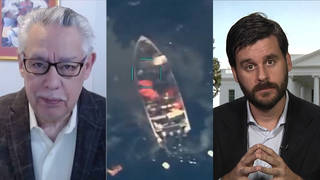
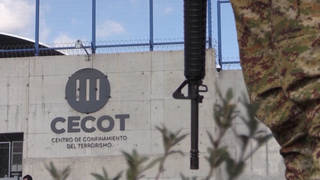
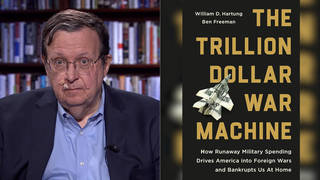
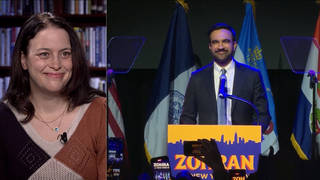





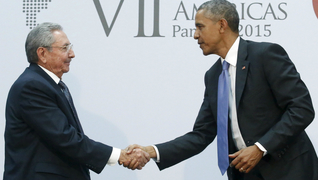
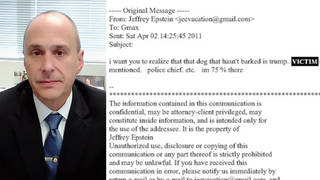
Media Options